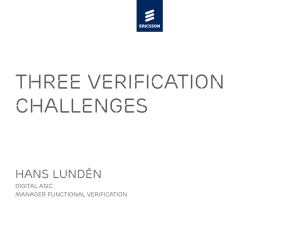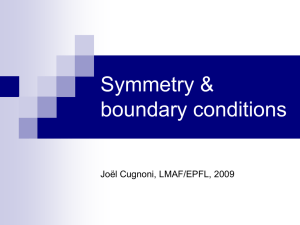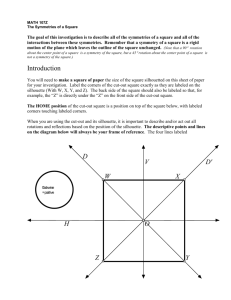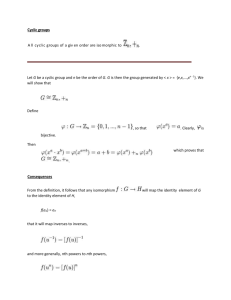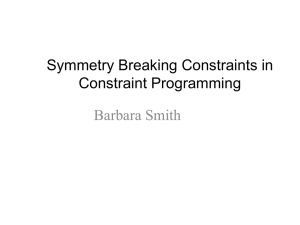PPT
advertisement
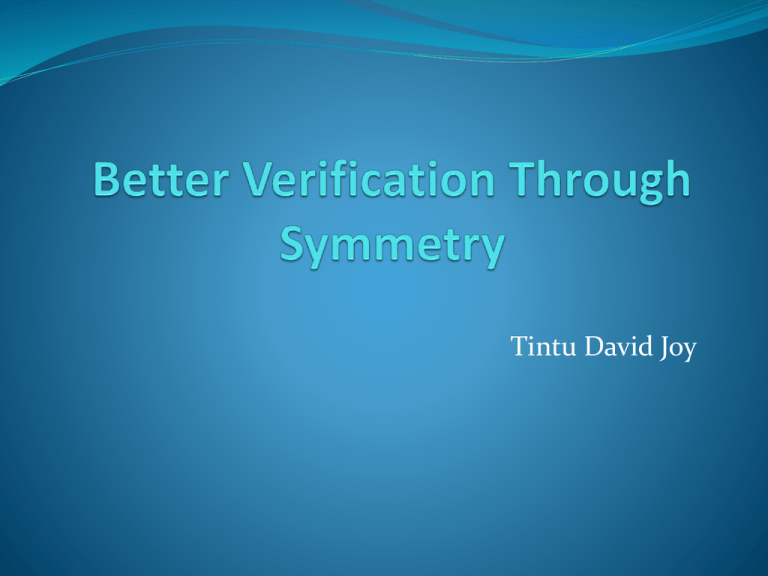
Tintu David Joy Agenda Motivation Better Verification Through Symmetry-basic idea Structural Symmetry and Multiprocessor Systems Murϕ verification system Scalarset Construction of Equivalent States Graph Automorphism Representative of the symmetry equivalence class Practical Results Conclusion 2 Motivation Network and communication protocols in hardware, protocols in large multiprocessors Protocols are becoming increasingly complex Proper verification is important Automatic verification of finite state concurrent systems State explosion problem Method to reduce the state space?? 3 Better Verification Through Symmetry • Aim: – Exploit Symmetries in the system – e.g. Mutual exclusion algorithm for 2 processes • Method: – Extending Murϕ verifier by adding scalar set – – Murϕ verifier -A verification system Scalar set- a new data type to detect symmetries – Equivalence relation between the states – Select one state per equivalence class as representative • Result: – Reduction of state space – More efficient verification 4 Example: Multiprocessor Systems Data consistency of local caches is important All processors access a shared global memory Directory based cache coherence protocol Set of rules for coordinating processors, cache controllers, memory controllers Protocol verification need to be done Without original state space Reduction of state space desirable 5 Structural Symmetry in Multiprocessor Systems 6 Structural Symmetry Directory tracks the processor Processors have distinct processor –id’s Properties of integers are irrelevant in high-level protocol description Here: ordering of processor id’s irrelevant for correctness of protocol 7 Structural Symmetry Standard Verifiers will not detect the symmetries Inspects symmetrically equivalent states many times Other symmetries Addresses, data values,memory module id‘s, message id‘s Consider multiple kind of symmetries Two problems: Detecting structural symmetries Detecting symmetrically equivalent states 8 Murϕ Verification System • Formal verification system for finite state concurrent systems • Mainly used in verifying multiprocessor systems and cryptographic protocols • Parts of Murϕ verification system – Description Language • Description of finite state asynchronous concurrent systems – Murϕ Compiler • C++ program, • generates reachable states and checks for execution of error statements, violation of invariants, deadlocks 9 Murϕ Description Language Declarations (constant, type, variable, procedure) Definitions(transition rule) Rules are guarded commands consisting of a condition and an action Nondeterministic selection of rules Atomic execution Descriptions (start state, invariant) 10 Example: 11 Scalarset New datatype in Murϕ To facilitate detection of symmetries and testing of equivalent states Features Assignment, testing equality/inequality and array indexing supported No arithmetic and comparison operators (other than equality/inequality testing) Convert the subrange to scalar set If numerical value of subrange not important Enforcing and documenting symmetries results from permuting members of scalar set 12 Example: 13 Construction of Equivalent States Aim: Obtain equivalent states Permuting scalar set entries of the set Permutation Process When Permutation applied to scalar set Value modified to corresponding permuted value An array indexed by scalar set permuted Contents of elements are permuted Elements are rearranged 14 Example: Equivalent states are basis for generating a reduced state space 15 Graph Automorphism To specify symmetry formally we use notions of state graphs and automorphisms Can be used to combine abstractly equivalent states Definition: A graph automorphism on a state graph A = (Q, S,Δ) is a one to one mapping h: A A 16 Graph Automorphism The transition relation is preserved Graph automorphisms closed under functional composition induces an equivalence relation on states Theorem: The set of permutations π on the scalar set entries in the states forms a set of graph automorphisms over the state graph. The set is closed under functional composition and the corresponding equivalence relation is a bisimulation 17 Representative of the symmetry equivalence class Only change in Murϕ verifier – canonical function is added Canonical function: determines a unique state to represent the equivalence class But finding canonical state is hard The large reduction in state space compensates for the computation load in canonicalization In complicated state structure the computation load in canonicalization is very high Observation: Any subset of states in the equivalence class can be used to represent the class and still give sound verification algorithm for safety properties 18 Normalization Canonicalization algorithm: all permutations are generated and lexicographically smallest state is used as canonical state So Normalization Algorithm Seperates states into two Part with most significant bits is canonicalized with few canonicalized permutations Second part is normalized by one permutation used to canonicalize the first part Result is a normalized state of a small lexicographically value 19 Practical Results Symmetry based algorithm in Murϕ verification system Verified cache coherence protocol on DASH multiprocessor Processing nodes communicating to memory modules Each processing nodes have its own processors and caches 20 Result on Cache coherence protocol Processing nodes- 2,3,4 Reduced state space by 90% 21 Data Saturation Exploiting data-independence Theorem: For any finite state system with M scalarsets that are not used as array indexes, there exists finite integers N1...Nm such that the reduced state graph has the same size as the one obtained from the system with the scalar sets of sizes N1...Nm or above, even if the sizes approach infinity. Reduce the infinite state space to a finite one 22 Conclusion Symmetry can be exploited in verification of concurrent systems Rotational symmetry can also be done in the same way Can be applied to other high level languages, specifications and models In several cases more efficient verification due to reduced state space 23 Thank you for the attention

